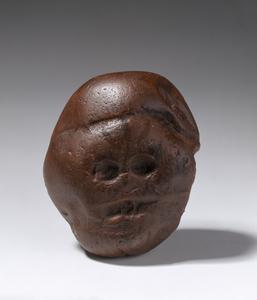While the use of tools by animals is unusual, Neil MacGregor points out in the second episode of A History of The World in 100 Objects, it’s not unique to humans: apes use objects, too, for example. The difference is that humans “make tools before we need them” and, more to the point, “we keep them,” for repeated use. The 1.8-million-year-old Olduvai chopping tool, then, suggests the dawning of a “relationship between humans and the things they create which is both a love affair, and a dependency. From this point on, we can’t survive without the things we make.”
In this instance, the chopping tool could be used to get at the meat and marrow of an animal that the actual predator who killed it (a lion, say) couldn’t. So here we have the birth of use-value — and, perhaps, the birth of design. This chopping tool shows humans becoming “distinctly smarter,” and considering “how to make things better,” MacGregor says. Interestingly, though, he also maintains that instead of the half-dozen or more chippings that sharpened this rock into a tool, the job could have been done in maybe two chippings: “Those chips tell us that right from the beginning, we, unlike other animals, have wanted to make things more complicated than they need to be.” Evidently, then, the dawn of design coincides with the dawn of … overdesign.
This notion comes up again in the series’ third episode, concerning another discovery from Tanzania’s Olduvai gorge: a handaxe. This is believed to be 1.2 million years old, and reflects a good deal more skill, forethought, and imagination on the part of its maker – the sort of “focused, planned creativity,” as MacGregor puts it, that marks modern humans.
James Dyson, however, is not impressed. Read more
The BBC radio series, A History of The World in 100 Objects has gotten underway, and I’m really into it. It’s written and hosted by the director of the British Museum, Neil MacGregor. Each episode lasts about 15 minutes, and the first one makes a brief case for history-via-objects by considering the Mummy of Hornedjitef, from the 3rd century B.C., described as “one of the most impressive mummy cases” in the British Museum. Like other objects this one sends the sort of “signals from the past” that things can carry. Since it arrived at the museum in 1835, scholars have translated the hieroglyphics and learned about the society the object came from, studied the charms and amulets entombed with the deceased to deduce that society’s beliefs about journeys of the afterlife, and examined its physical makeup to extrapolate the trading networks of the age. Such objects keep sending new signals, as scholars figure out how to receive them.
In the second episode MacGregor dials us back to the beginning of his story: a 1.8 million-year-old “stone chopping tool” found in Olduvai Gorge, in Tanzania (by a Ricahrd Leakey expedition, under the auspices of the British Museum). Discovered next to bones, the chopping tool seems to have been shaped to strip meat and break into the bones of killed wildebeests and the like. “A very, very versatile kitchen implement,” MacGregor offers.
Although the series is explicit in telling the story of human history by way of things humans have made, I think a history of humanity told via objects ought to start with the Makapansgat Pebble (below). As you can see, it looks like a face. It was found in what is now South Africa, and is estimated to be about 3 million years old. What’s significant about it is that the experts believe, based on the makeup of the pebble, that the spot where they found it, among ancient bones and whatnot, indicate that some hominid/human ancestor carried the thing several miles, which would make it the oldest known manuport.

Makapansgat Pebble
Why was carried away from its place of origin? Well, obviously we don’t know the precise answer, but clearly it’s not a matter of use-value: The pebble is not functional, it’s not a tool. I once heard Mia Fineman, a Met curator and writer, give a talk in which she brought up the Makapansgat Pebble in the context of pareidolia. Pareidolia basically involves spotting patterns that are basically random and attributing meaning to them — like seeing the Virgin Mary’s face in a grilled-cheese sandwich. Possibly the proto-human believed that there was something supernatural about a pebble that looked like a person. Read more




 "
"













 Kim Fellner's book
Kim Fellner's book  A
A